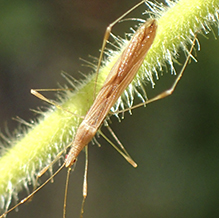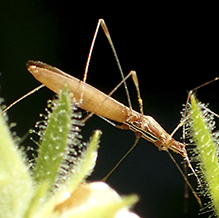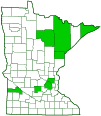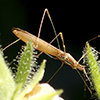stilt bug
(Neoneides muticus)
Conservation • Description • Habitat • Ecology • Distribution • Taxonomy
Conservation Status |
|
|||||||
| IUCN Red List | not listed |
|||||||
| NatureServe | NNR - Unranked |
|||||||
| Minnesota | not listed |
|||||||
Description |
||
Neoneides is a genus of stilt bugs in the family Berytidae. There is only one described species in the genus, Neoneides muticus. Neoneides muticus is a small, delicate, stilt bug. It occurs in the United States and southern Canada in the east and in the west, but it is mostly absent from the Great Plains. It is found from late May to late September in weedy fields and pastures. Adults are 5⁄16″ to ⅜″ (8.2 to 9.5 mm) in length. The body is long, very slender, cylindrical, and pale brownish. It is covered with appressed woolly hairs. The head is small, cone-shaped, long, and much narrower than the thorax. There is a distinct neck. At the front of the head there is a rounded lobe (tylus) that curves downward. There are two compound eyes on the sides of the head and two simple eyes (ocelli) on the top of the head (vertex). The vertex is expanded forward into a spine. The spine is long but barely reaches the middle of the tylus. The compound eyes are small and are very far from the base of the head. The ocelli have a tear-drop shaped base. Immediately in front of the ocelli there is a transverse groove that continues to the hind margin of the eyes. The mouthparts are optimized for piercing and sucking and formed into a long, slender beak with four segments. The antennae are very long, thread-like, and elbowed. They have four segments. The first segment is very long and is thickened at the end. The second segment is half as long as the first, and the third is about as long as the first. The fourth is much shorter than any of the others. It is spindle shaped, obviously thickened, and dark blackish-brown The plate over the thorax (pronotum) is much longer than wide. The rear margin is convex. There is a longitudinal ridge in the middle but only in the basal portion. The surface is densely and coarsely pitted (punctate). The plate between the wing bases (scutellum) is very small. It does not have a spine or knob (tubercle) at the base. The abdomen is long and slender and has ten segments. The wing covers (hemelytra) are narrow and long, reaching the tip of the abdomen. They are held roof-like over the body when at rest. They have a thickened leathery section at the base and a thin membranous section at the tip with a clear dividing line between the two. The thickened basal part is comprised of a narrow area (clavus) behind the scutellum when the wings are closed, and the remaining, broad, marginal area (corium). The clavus and corium are strongly punctate. The leading edge (costal margin) of the corium extends well beyond the middle of the membranous area. The membranous area is relatively short and is finely wrinkled. The legs are very long, thread-like, and pale. They are more or less thickly covered with short bristles. The hind legs are very long, much longer than the front legs. This is the feature that gives the family its common name. The third segment (femur) of each leg is thickened at the end. The fourth segment (tibia) on the front legs is unarmed, having no spines. The last part of each leg (tarsus), corresponding to the foot, has three segments. On all legs, the tips of the tibia and the tarsus are dark blackish-brown. |
||
Size |
||
Body length: 5⁄16″ to ⅜″ (8.2 to 9.5 mm) |
||
Similar Species |
||
Habitat |
||
Fields |
||
Ecology |
||
Season |
||
Late May to late September (CCESR) |
||
Behavior |
||
Adults are active during the day. They move slowly. |
||
Life Cycle |
||
Adults overwinter. |
||
Nymph Food |
||
|
||
Adult Food |
||
Plant juices |
||
Distribution |
||||
|
Sources |
|||
| 7/14/2023 | ||||
Occurrence |
||||
Uncommon in Minnesota |
||||
Taxonomy |
|||
Order |
Hemiptera (True bugs, Hoppers, Aphids, and Allies) | ||
Suborder |
Heteroptera (True Bugs) | ||
Infraorder |
Pentatomomorpha | ||
Superfamily |
Lygaeoidea (seed bugs and allies) | ||
Family |
Berytidae (stilt bugs) | ||
Subfamily |
Berytinae | ||
Tribe |
Berytini | ||
Genus |
Neoneides | ||
Synonyms |
|||
Neides muticus |
|||
Common Names |
|||
This species has no common name. The common name of the family Berytidae is stilt bugs, and it is applied here for convenience. |
|||
Glossary
Femur
On insects and arachnids, the third, largest, most robust segment of the leg, coming immediately before the tibia. On humans, the thigh bone.
Hemelytron
The forewing of true bugs (order Hemiptera), thickened at the base and membranous at the tip. Plural: hemelytra.
Ocellus
Simple eye; an eye with a single lens. Plural: ocelli.
Pronotum
The exoskeletal plate on the upper side of the first segment of the thorax of an insect.
Punctate
Dotted with pits (punctures), translucent sunken glands, or colored spots of pigment.
Scutellum
The exoskeletal plate covering the rearward (posterior) part of the middle segment of the thorax in some insects. In Coleoptera, Hemiptera, and Homoptera, the dorsal, often triangular plate behind the pronotum and between the bases of the front wings. In Diptera, the exoskeletal plate between the abdomen and the thorax.
Tarsus
On insects, the last two to five subdivisions of the leg, attached to the tibia; the foot. On spiders, the last segment of the leg. Plural: tarsi.
Tibia
The fourth segment of an insect leg, after the femur and before the tarsus (foot). The fifth segment of a spider leg or palp. Plural: tibiae.
Tubercle
On plants and animals: a small, rounded, raised projection on the surface. On insects and spiders: a low, small, usually rounded, knob-like projection. On slugs: raised areas of skin between grooves covering the body.
Vertex
The upper surface of an insect’s head.
Visitor Photos |
|||||
Share your photo of this insect. |
|||||
| This button not working for you? Simply email us at info@MinnesotaSeasons.com. Attach one or more photos and, if you like, a caption. |
|||||
Babette Kis |
|||||
Stilt bugs were on Potentilla arguta, Prairie cinquefoil, August 3, 2022. They were found at Barnes Prairie, Racine Co., Wisconsin. |
 |
||||
 |
|||||
MinnesotaSeasons.com Photos |
|||||
|
|||||

Slideshows |
||

Visitor Videos |
|||
Share your video of this insect. |
|||
| This button not working for you? Simply email us at info@MinnesotaSeasons.com. Attach a video, a YouTube link, or a cloud storage link. |
|||
Other Videos |
|||
| Waving Of Stilt Bugs | Neoneides Muticus Saagaa Vanam |
|||
About
Apr 5, 2022 Neoneides muticus is a species of stilt bug in the family Berytidae. They are often found on plants that have a long, sticky, hair-like covering. They move slowly and mostly feed on plants, but sometimes prey on small insects. |
|||


Created: 7/14/2023
Last Updated:

